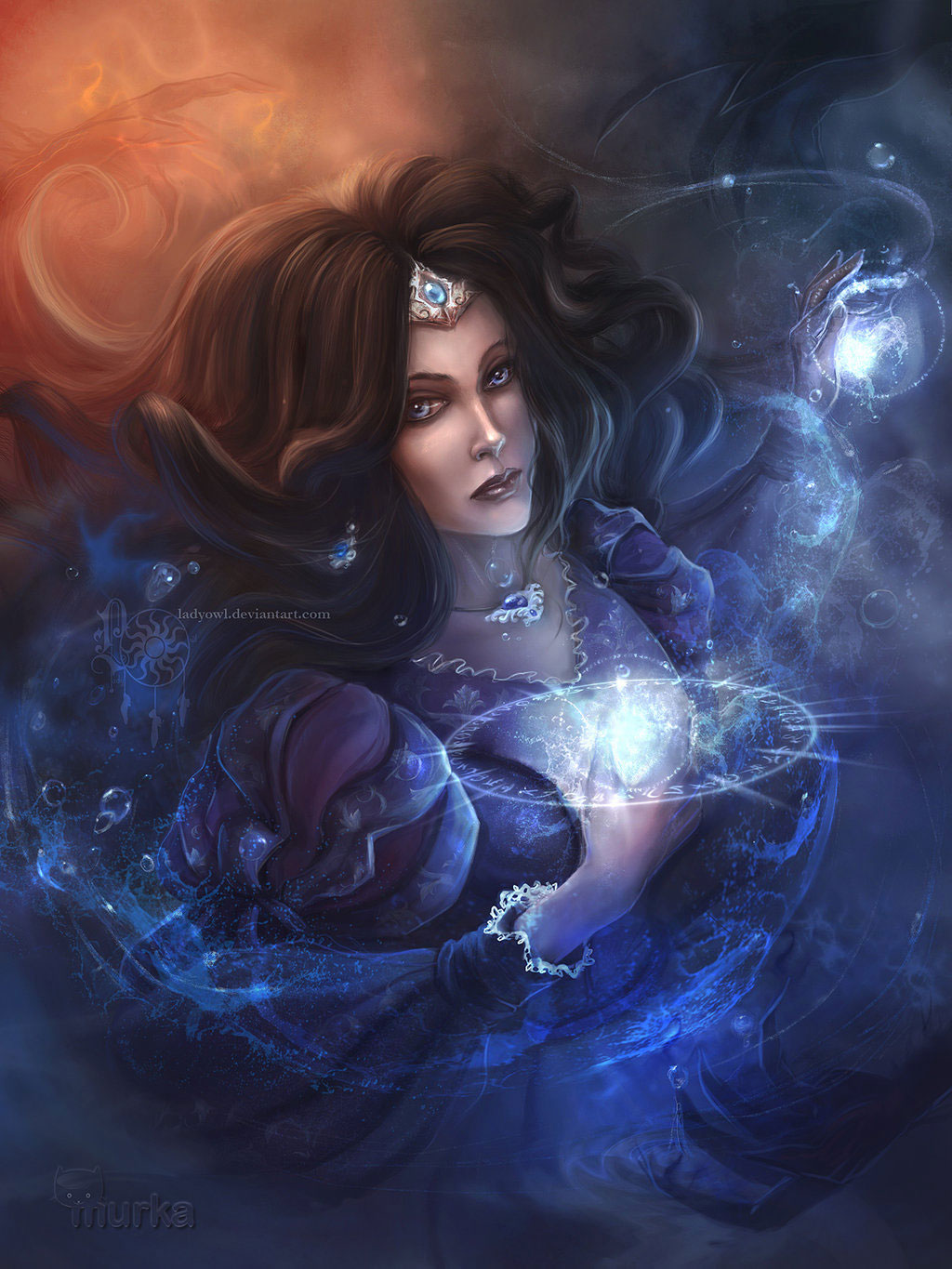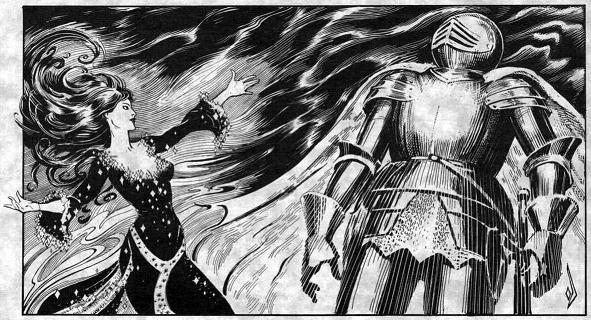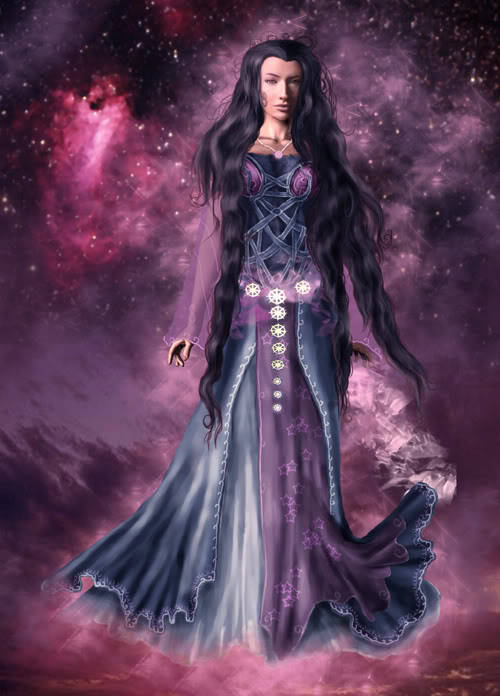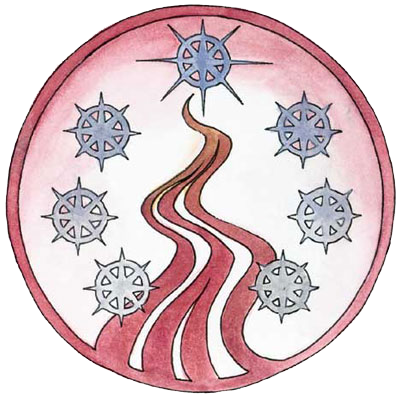Mystra, the Mother of all Magic or Lady of Mysteries, is a greater deity and the goddess of magic. Mystra provides for and tends to the Weave constantly, making possible all the miracles and mysteries wrought by magic and users of magic. Some believe her to be the embodiment of the Weave and of magic itself. In fact, Cyric’s attempted assassination of her in 1385 DR resulted in the Spellplague, when she was no longer able to tend it. Mystra is also the deity of the possibilities that magic can bring about, making her one of the most powerful beings in the Realms. Although she favors the ethos of good, she has learned that, as deity of magic, she must preserve the Balance. While she can prevent the creation of new spells and magic items that her philosophy opposes, she rarely exercises this ability unless they threaten the Weave or magic in general. Mystra appears as a beautiful human woman with dark, flowing hair and radiant skin. Mystra’s symbol is a ring of seven stars surrounding a rising red mist, spiraling to the heavens. Mystra rules over the divine dominion of Dweomerheart, on the plane of Elysium.
![]()
History
Mystryl – the first Goddess of Magic
 Legend has it that, at the dawn of time, Lord Ao created the universe, and out of the early chaos came twin deities: Shar of the darkness, and Selûne of the light. Together, these two beings created the spheres in the firmament, one of which was the world of Abeir-Toril and the other, its spirit: Chauntea. Chauntea desired new and more abundant life for her world and asked the sisters for light and warmth in order to nurture it. In this, the two beings could not agree. Selûne eventually acted on her own and gave Toril a sun, which Shar immediately sought to put out, thus beginning the battle between light and darkness that raged for eons. At some point, the Dark Goddess got the upper hand and doused many of Selûne’s motes of light. In a desperate move, Selûne tore a piece of magical essence from herself and hurled it at her sister. When it hit, Shar also lost a portion of her essence and was cast into the void for centuries. From the blending of dark and light energies, Mystryl was born as a being of pure magic inextricably tied to the Weave. Both of the twins were diminished as a result, with the Moonmaiden’s wound being more grave. However, Mystryl was ideologically closer to Selûne and, being created from both light and darkness, she (as well as later goddesses of magic) acted as a balancing force between Selûne and the Lady of Loss.
Legend has it that, at the dawn of time, Lord Ao created the universe, and out of the early chaos came twin deities: Shar of the darkness, and Selûne of the light. Together, these two beings created the spheres in the firmament, one of which was the world of Abeir-Toril and the other, its spirit: Chauntea. Chauntea desired new and more abundant life for her world and asked the sisters for light and warmth in order to nurture it. In this, the two beings could not agree. Selûne eventually acted on her own and gave Toril a sun, which Shar immediately sought to put out, thus beginning the battle between light and darkness that raged for eons. At some point, the Dark Goddess got the upper hand and doused many of Selûne’s motes of light. In a desperate move, Selûne tore a piece of magical essence from herself and hurled it at her sister. When it hit, Shar also lost a portion of her essence and was cast into the void for centuries. From the blending of dark and light energies, Mystryl was born as a being of pure magic inextricably tied to the Weave. Both of the twins were diminished as a result, with the Moonmaiden’s wound being more grave. However, Mystryl was ideologically closer to Selûne and, being created from both light and darkness, she (as well as later goddesses of magic) acted as a balancing force between Selûne and the Lady of Loss.
In -339 DR, the Netherese archwizard Karsus took it upon himself to defeat the phaerimm that were threatening the Netherese empire. He had spent years researching Karsus’s Avatar, the most powerful spell ever created, designed to temporarily rob a deity of their power and grant it instead to the spellcaster. Karsus chose to rob Mystryl, and, when her godly essence poured into him, his mind and body were overwhelmed and he found that he was incapable of wielding such power. Mystryl’s hold on the Weave was weakened, and it began to unravel. Magical effects doubled in power briefly, then became wild and chaotic. To save the Weave from permanent damage, Mystryl chose to sacrifice herself. This broke Karsus’s connection, killing him, and stopped all magic for a short time. In the time it took for the Mother of All Magic to reincarnate herself, most of the floating cities of Netheril crashed to the ground.
Mystra – the second Goddess of Magic
Moments after the Fall of Netheril, a peasant girl with rudimentary magical training–but an aptitude for spells–became the new Goddess of Magic, and managed to catch three of Netheril’s floating cities as they plummeted, bringing them to rest on the ground and saving thousands of her people. Being of a more lawful disposition than her predecessor, she laid down new rules for all spellcasters, banning the most powerful spells, limiting who had access to magic, limiting how many spells of each power level could be held in the mind, increasing the time it took to cast spells, and forcing long periods of memorization or prayer each day to replace spells cast previously.
 As the centuries passed, Mystra grew tired of the ceaseless grasping for power through pleading, flattery, or treachery. She and her portfolio were the target of gods and mortals alike, and that took its toll on the Mother of All Magic. Being thrown down to Toril with all the other gods during the Time of Troubles was apparently the last straw. Mystra opened a gate to the Ethereal Plane and traveled to the Celestial Stairway, which was guarded by Helm (the only deity to retain his power, charged by the Overgod to guard the entrance to the heavens). Mystra argued with Helm, saying she had nothing to do with the theft of the Tablets of Fate and to let her pass so that she might speak to Lord Ao and regain her rightful place as keeper of the Weave. Helm steadfastly refused to let her pass, and gave her fair warning. Furious, she attacked him with bolts and beams of energy, fire and ice, mystic blades and magical hammers, and dread creatures with fangs and claws, coils and maws, wings and tentacles. Helm held firm, absorbing or brushing off each of her assaults. Weeping blue-flame tears of anger and frustration, she grappled with Helm, and fire leaped from her mouth. Helm held her off with one hand and raised his visor. As their gaze met, Mystra let out a terrible scream heard across the Realms as she saw her doom written in his face. Helm drew back and punched his gauntleted fist through her chest, and her avatar’s body exploded in a blindingly hot flash of devastating power.
As the centuries passed, Mystra grew tired of the ceaseless grasping for power through pleading, flattery, or treachery. She and her portfolio were the target of gods and mortals alike, and that took its toll on the Mother of All Magic. Being thrown down to Toril with all the other gods during the Time of Troubles was apparently the last straw. Mystra opened a gate to the Ethereal Plane and traveled to the Celestial Stairway, which was guarded by Helm (the only deity to retain his power, charged by the Overgod to guard the entrance to the heavens). Mystra argued with Helm, saying she had nothing to do with the theft of the Tablets of Fate and to let her pass so that she might speak to Lord Ao and regain her rightful place as keeper of the Weave. Helm steadfastly refused to let her pass, and gave her fair warning. Furious, she attacked him with bolts and beams of energy, fire and ice, mystic blades and magical hammers, and dread creatures with fangs and claws, coils and maws, wings and tentacles. Helm held firm, absorbing or brushing off each of her assaults. Weeping blue-flame tears of anger and frustration, she grappled with Helm, and fire leaped from her mouth. Helm held her off with one hand and raised his visor. As their gaze met, Mystra let out a terrible scream heard across the Realms as she saw her doom written in his face. Helm drew back and punched his gauntleted fist through her chest, and her avatar’s body exploded in a blindingly hot flash of devastating power.
Mystra – the third Goddess of Magic
 Before her ascension to godhood, the second Mystra was a human wizard named Midnight, who, along with the future gods Kelemvor and Cyric, played a large role during the Time of Troubles. When the gods were cast down by Ao, Midnight joined with the fighter Kelemvor, the thief Cyric, and a Cleric of Sune named Adon in the search for the stolen Tablets of Fate. When the previous Mystra was killed by Helm for defying Ao’s command, her death caused great damage to the Weave. Eventually, Ao selected Midnight to replace the destroyed goddess, and she reluctantly accepted–taking Mystra’s name in order to smooth the transition after so much chaos.
Before her ascension to godhood, the second Mystra was a human wizard named Midnight, who, along with the future gods Kelemvor and Cyric, played a large role during the Time of Troubles. When the gods were cast down by Ao, Midnight joined with the fighter Kelemvor, the thief Cyric, and a Cleric of Sune named Adon in the search for the stolen Tablets of Fate. When the previous Mystra was killed by Helm for defying Ao’s command, her death caused great damage to the Weave. Eventually, Ao selected Midnight to replace the destroyed goddess, and she reluctantly accepted–taking Mystra’s name in order to smooth the transition after so much chaos.
Midnight was not long the goddess of magic when, in the Year of Blue Fire, 1385 DR, Cyric attempted to assassinate her, at the behest and with the aid of Shar, who sought to obtain control over the Weave. The results of Midnight’s disappearance, however, were far worse than Shar had supposed it would be, and the Spellplague soon followed, causing magic throughout the planes to go wild. In the Year of the Ageless One, 1479 DR, a few of Mystra’s Chosen found the Lady of Mysteries in a greatly diminished state, and assisted in restoring her power and divinity… but it was not until 1487 DR that the goddess was whole again.
![]()
Divine Relations
Mystra’s closest adviser is Azuth, although the Lord of Spells is less close than he used to be. Savras and Velsharoon serve Azuth, and thus indirectly report to Mystra as well. The Mother of All Magic maintains close alliances with deities of knowledge, as well as the deities of magic in other pantheons, including Corellon Larethian. While not as close to her former mortal lover, Kelemvor, following his judgement of their mutual companion Adon, she still counts him an ally. Mystra loathes the rise of Bane and hates Cyric with a passion for all he has done, but Mystra’s chief antagonist is Shar. Mystra knows that Cyric would have never found the courage to follow through with his attempted assassination without Shar’s coaxing. Additionally, Shar secretly created the Shadow Weave long ago in response to Selûne’s creation of Mystra and the Weave (to which Shar inadvertently contributed as well). Mystra sees Shar’s actions as a direct attack to her own portfolio and a grave danger to the integrity of the Weave, and has made it a priority to ensure that the Shadow Weave is not recreated.
![]()
Church / Worshipers
Mystran clergy work hard to preserve all magical lore so that magic can flourish in the future regardless of what befalls the thinking races of Abios or the powers of the planes. They maintain secret libraries, private safe holds, well-guarded research laboratories, and small, hidden stashes. Mystrans also search out beings skilled in spell use and keep watch on the power and behavior of individuals likely to become magic-wielders of importance. The clergy actively seek out sources of old magic, often from tombs, dangerous ruins–even liches. They consider it more crucial to know the precise location of artifacts and items of magical power than to possess them, but wherever possible, they work to wrest control of such things from the aggressively evil, the irresponsible, and the unsound of mind. All clergy of Mystra are expected to devise their own new magic (whether it be spells or items) upon gaining sufficient experience. In this way, magical study remains a growing, vibrant thing, and magic is not merely seen as a handy tool for rulers and engineers to tame Toril, but remains a thing of wonder.
 Temples of Mystra can be almost any size and style of structure; some shrines are natural caves or grottoes. All are living works of art–or rather, Art–raised with magic and en wrapped in countless spells. Most are filled with magic items, many of which are of an esoteric rather than practical nature. Most include an open central courtyard in which daily services are held and from which one can see the stars at night or a magical representation of them. Lesser rooms house libraries of magical lore or serve as work shops and laboratories for experimentation in the Art. Sites dedicated to the deity are enhanced by the Weave to augment spellcasting power. Any spells cast within by her clerics can benefit from one metamagic feat (as the sorcerer ability); the benefit ends if the recipient leaves the location of the temple.
Temples of Mystra can be almost any size and style of structure; some shrines are natural caves or grottoes. All are living works of art–or rather, Art–raised with magic and en wrapped in countless spells. Most are filled with magic items, many of which are of an esoteric rather than practical nature. Most include an open central courtyard in which daily services are held and from which one can see the stars at night or a magical representation of them. Lesser rooms house libraries of magical lore or serve as work shops and laboratories for experimentation in the Art. Sites dedicated to the deity are enhanced by the Weave to augment spellcasting power. Any spells cast within by her clerics can benefit from one metamagic feat (as the sorcerer ability); the benefit ends if the recipient leaves the location of the temple.
The ceremonial garb of Mystran clerics consists of simple blue robes, sometimes trimmed with white, accented by a cloak of deep blue in colder climates. Some form of blue headgear is required, though this may range from a plain skullcap to wide, ornate hats and helms.
All wielders of magic and seekers after arcane lore of any race are welcome in the service of Mystra. The hierarchy of the Mystran faith is wide and varied, separating into orders concentrating on one form of magical energy. Relations between the various orders and subgroups of the faith are very good. Both divine and arcane spell casters fill its ranks without regard to experience level or origin. The general rule of the Mystran faith is that talent and ability outweigh social rank or legendary feats.
The church also sponsors three small orders:
- Rangers, known as the Order of the Shooting Star, that serve as long-range scouts and spies for the church. They also deal with magical threats against the natural order of things, such as unloosed fiends and creatures born of irresponsible arcane experimentation.
- Bards of the Children of the Starry Quill, who often work as information gatherers and rumormongers for the church or spend time in libraries unearthing magical knowledge and preserving it for posterity.
- The Knights of the Mystic Fire are an order of paladins. The Mystic Fire Knights regularly join priests of Mystra on missions to find and uncover lost stores of ancient magic. They also serve as guardians at large for Mystran temples and at magical workshops, usually as leaders of regular defenders.
The Chosen of Mystra are, similarly to the Chosen of other deities, mortals who have been specifically blessed by Mystra. Due to this blessing they gain access to unprecedented magical power. Mystra’s Chosen are all concerned with fighting evil and imbalances in the Weave. Mystra’s numerous Chosen include Elminster, Khelben “Blackstaff” Arunsun, and the Seven Sisters.
![]()
Dogma
Love magic for itself. Do not treat it just as a weapon to reshape the world to your will. True wisdom is knowing when not to use magic. Strive to use magic less as your powers develop, for often the threat or promise of its use outstrips its actual performance. Magic is Art, the Gift of the Lady, and those who wield it are privileged in the extreme. Conduct yourself humbly, not proudly, while being mindful of this. Use the Art deftly and efficiently, not carelessly and recklessly. Seek always to learn and create new magic.
![]()
